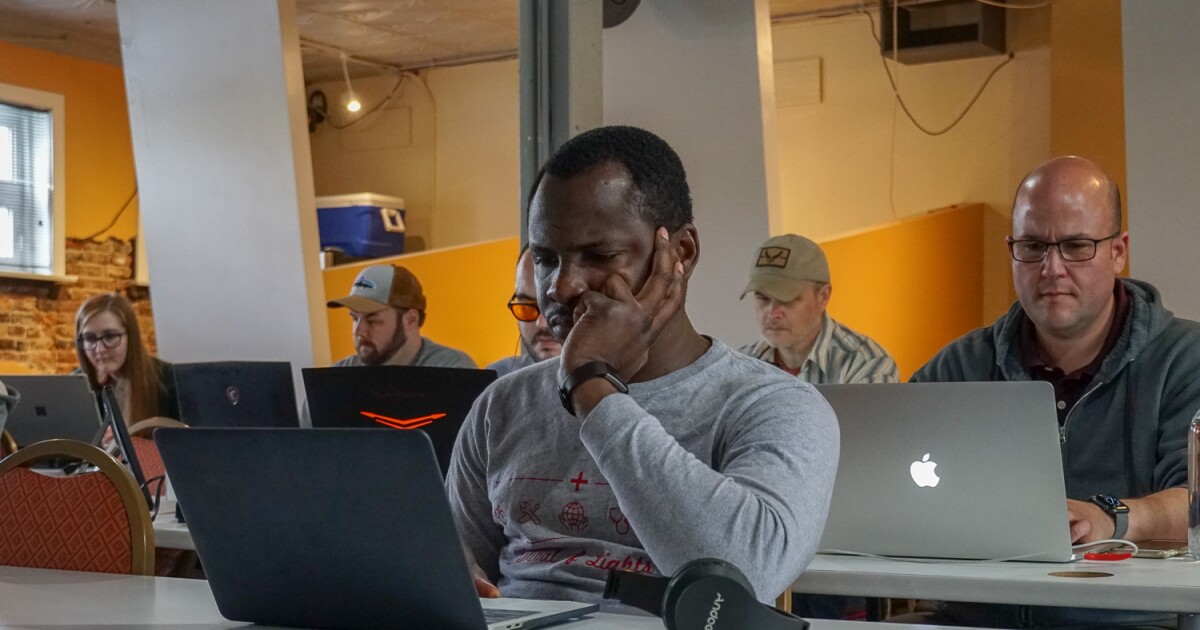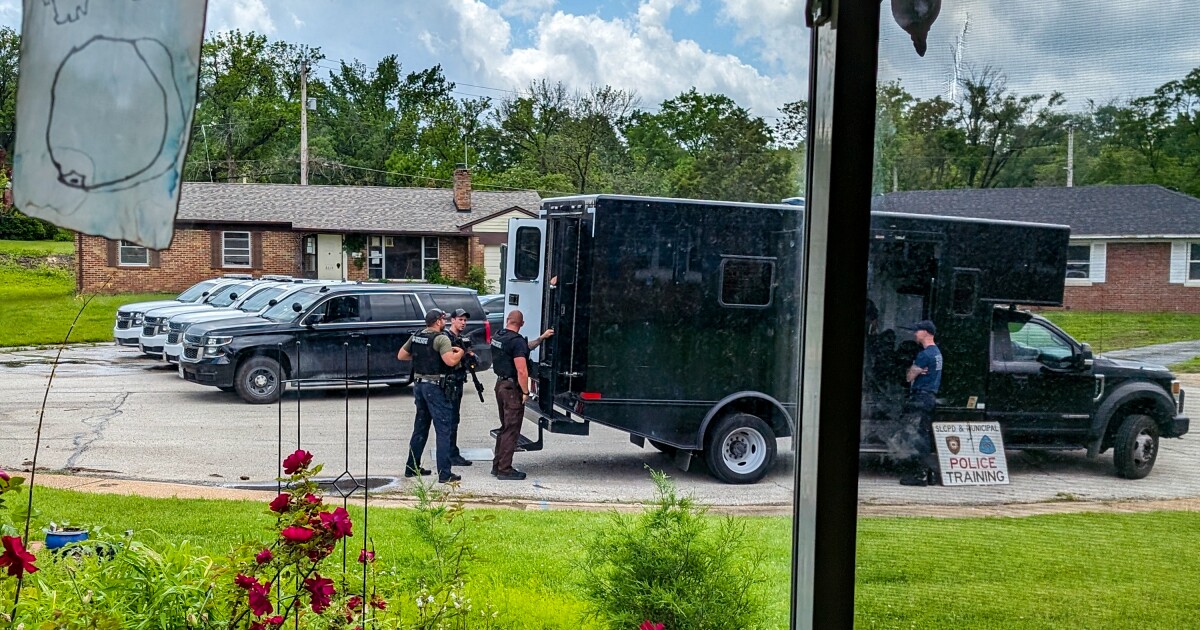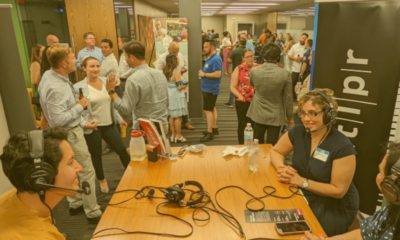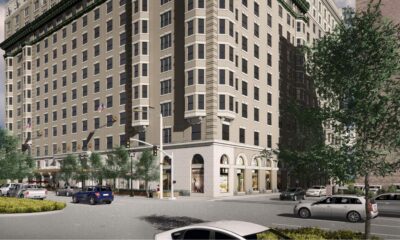Business
Immigrants in St. Louis are making economic contributions

Although the St. Louis region’s population growth has leveled off over the past decade, there has been a modest increase in the area’s immigrant population. Demographers say this increase is a small but helpful contribution to the economic vibrancy of the region.Immigrants living in the metropolitan area make up 4.8% of the total population. According to a recent analysis by the American Immigration Council, immigrant households in the area earned $5.9 billion in total income, paid $1.6 billion in taxes and held $4.3 billion in spending power.Immigrant families play a vital role in the region’s economic success, said Ness Sandoval, professor of demography and sociology at St. Louis University.“Even though our immigrant population is relatively small — compared to Chicago, Miami or New York — the region is still benefiting from the economic power of this group,” he said. “Imagine what that economic power would be like if the immigrant population was three times as large.”New U.S. Census Bureau data shows that the region dropped from being the 21st largest metropolitan area to the 23rd, in the year ending July 1, 2023. Both the Charlotte and Orlando metropolitan areas surpassed St. Louis. Last year, the city lost about 3,250 residents. Also, St. Louis County lost over 3,730 people.Though there is a population loss, many immigrants are finding their way to the area. Today, over 130,000 immigrants call the region home.Sandoval said the region’s immigrant population needs to be over 10% to be consistent with its peers among the top 20 metropolitan regions.“Imagine the types of businesses that would be out there generating jobs contributing back to the economy, businesses that would be supporting nonprofits,” he said. “That’s not here right now, because we don’t have those immigrant businesses, but the ones that are here, we can already see that economic impact.”Nigerian entrepreneur Ola Ayeni moved from Chicago to St. Louis over a decade ago to open Claim Academy, a software engineering and cybersecurity training school. Arch Grants awarded him $50,000 in 2013 to start the company in St. Louis.“St. Louis has been positive for me because I remember when I [first] moved here, I got a lot of support,” Ayeni said.Ayeni was immediately connected to the International Institute and the St. Louis Mosaic Project, as well as other organizations in the area that help immigrants establish themselves in the region.He credits his success to Arch Grants. Today, the academy employs over 20 people, which include immigrants and native born citizens. Ayeni said the company’s finances are consistently in the black and it brings in millions of dollars a year.Although many immigrants own profitable businesses in the city, Sandoval said he is seeing more immigrants open businesses in municipalities along the Interstate 270 corridor.“We are in competition. Many, many cities and regions across the United States want immigrants to move to their region for the reason of the economic activity that they bring to the region,” he said. “Immigrants are more likely to start small businesses compared to American born citizens, and so this is exciting for the business community to see new businesses created.”Ayeni is also contributing to the region’s economy. Besides the software engineering school, he owns a facial company in Chesterfield and is a real estate investor.St. Louis city and county leaders want to increase the population to grow the economy. Although the immigrants’ economic contributions are a small fraction of the region’s total economy, it is a big fraction, compared to its size of population, Sandoval said.To keep attracting immigrants, he said St. Louis has to put forth more efforts that will continue to increase immigrants’ quality of life.“Immigrants who are saying, ‘I don’t want to live in Houston, I want to find another city, I want to find my American dream,’” Sandoval said. “And so that’s where these institutions come into play, because they can now start to advocate and start to promote what the American dream looks like in the St. Louis metropolitan region.”
Business
Police train in abandoned homes in U City Costco development

In 2008, Nichole Angieri opened her front door for the first time as a homeowner on Mayflower Court in University City. Over the next decade, she got to know her neighbors as part of the fabric of a multi-generational community. She walked to her favorite restaurants. She listened to birds in her backyard.“I have wonderful memories,” Angieri said, recalling the Easter egg hunts, gardens and kind neighbors who helped with her children when they were little.“My children grew up climbing all of the trees in all of the neighbors’ yards,” she continued. “It was our community.”Today, the street is unrecognizable to her. Nearly half its sixteen homes are vacant, abandoned in the aftermath of a yearslong development that erected a Costco in University City while pushing out immigrant-owned businesses.Two weeks ago, Angieri opened her door and saw something new on Mayflower Court: Numerous police vehicles and officers were staged at the entrances to homes, where they drilled on their positioning with battering rams and other tactics for forced entry. The officers came back to Mayflower multiple times to use the homes that once held Angieri’s neighbors as practice targets.Angieri called the drills “another violation against the residents of Mayflower Court’s ability to live peacefully and undisturbed” in a Tuesday email complaining to city officials.“We have already been disturbed by the noise from the construction, the light pollution that we now experience from the parking lots, and the removal of beloved trees that lined our streets,” she told St. Louis on the Air.The homes on Mayflower spent years in the shadow of the adjacent, $190 million Costco-anchored development. Other nearby neighborhoods were subject to buyouts and the threat of eminent domain. Mayflower was supposed to be next for that treatment — instead, commercial real-estate firm Seneca abruptly pulled out of the deal last summer, stunning homeowners who had refused to move.Larry Chapman, president and CEO of Seneca, blamed the reversal on losing key retailers, as well as rising interest rates. He told the Post-Dispatch in December 2023, “We are disappointed, just like the homeowners are, that we were unable to close.”Seneca quickly sold the seven homes it had bought on Mayflower. The new owner, Arnold-based Paisley Park LLC, allowed the St. Louis County Police Department to use the homes for tactics practice.“We train wherever people will give us facilities, buildings, businesses or homes,” Sgt. Tracy Panus confirmed. “We sign agreements with them.”Panus said that the training on Mayflower did not involve the use of loud noises like flashbangs or battering rams. We try to be as cognizant of the community that we’re in as possible.”Panus added that the department alerted University City to the training exercises. “We wouldn’t just go into a municipality and train there without them being aware of what’s going on,” she said.For Angieri, the new reality of her neighborhood is hard to stomach. She is adamant about staying in her home and standing up for what is left of her community.“My children unfortunately have spent the last seven years watching their neighborhood be dismantled. They have slowly watched neighbors move out. They have gone from a fully secure, safe neighborhood, and overnight, to a neighborhood with boarded-up buildings.”“Next,” she added, “is for me to continue to fight for my neighborhood.”To hear more about the police presence on Mayflower Court and how homeowners like Angieri are dealing with a development that’s reshaped their community, listen to St. Louis on the Air on Apple Podcast or Spotify or by clicking the play button below.
Why SWAT teams are using U City homes to train
Listen to Nichole Angieri and producer Danny Wicentowski on ‘St. Louis on the Air’
“St. Louis on the Air” brings you the stories of St. Louis and the people who live, work and create in our region. The show is produced by Ulaa Kuziez, Miya Norfleet, Emily Woodbury, Danny Wicentowski, Elaine Cha and Alex Heuer. Roshae Hemmings is our production assistant. The audio engineer is Aaron Doerr.
Business
Group selling East St. Louis homes to use money on new projects
Editor’s note: This story was originally published in the Belleville News-Democrat.Faith-based nonprofit Lansdowne Up is preparing to sell some of the $360,000 homes it built in a new East St. Louis housing development, officials announced at a news conference and open house on Saturday.And the money from the home sales will go back into the community, according to Mark Mestemacher, founder and president of the Lansdowne Up board.Lansdowne Up is named after the Lansdowne neighborhood in East St. Louis that it’s working to redevelop.The nonprofit has been purchasing properties there to renovate or demolish existing houses and to construct new ones like those in the housing development, a 20-home subdivision called Lansdowne Park.Lansdowne Park is located at the corner of North 25th Street and Gross Avenue. Kevin Green, Lansdowne Up’s director of administration, said it had once been the site of a community park, an extension of nearby Jones Park. But over time the area became blighted.Now, some of the new three-bedroom homes are ready for occupancy and the nonprofit is looking for buyers. Other homes in the subdivision remain under construction, slated to be finished by the end of the summer.Mestemacher said the money they make will help them continue cleaning up properties in the neighborhood. The nonprofit also has plans for another housing development half a mile away from Lansdowne Park.
Joshua Carter
/
Belleville News-DemocratEmployees at faith-based nonprofit Lansdowne Up stand and watch a presentation of the new neighborhood they helped build on Saturday in East St. Louis.
Joshua Carter
/
Belleville News-DemocratEast St. Louis native and six-time Olympian Jackie Joyner-Kersee claps on Saturday during the presentation of the new Lansdowne Park subdivision in East St. Louis.
On Saturday, nonprofit leaders shared details about the next development, opened the finished homes for tours and addressed questions about their high cost in a community where about 30% of the residents live in poverty.Attendees included East St. Louis native and Lansdowne board member Jackie Joyner-Kersee, East St. Louis Mayor Charles Powell III, and three Illinois lawmakers: State Rep. Kevin Schmidt and State Sens. Chris Belt and Erica Harriss.NAACP East St. Louis branch president questions costs During the event, NAACP East St. Louis branch president Robin Carey-Boyd asked the nonprofit leaders how the average person in East St. Louis could afford a Lansdowne Park house. The median household income in the city is $28,519, according to U.S. Census Bureau estimates.“The average person is not going to be a resident in this particular neighborhood,” Green said in response to Carey-Boyd. “These homes are designed for the person from East St. Louis who has chosen to leave because they couldn’t find housing like this.”Lorenzo Savage, co-founder of I Am East St. Louis, The Foundation, said higher-value homes will help with the high tax burden homeowners currently face in East St. Louis. In cities with lower property values, the tax rate that determines how much each resident pays is higher.“It’s helping you with your taxes. And it’s encouraging other people to move back home,” Savage said. “… We need our people who work here to live here and have that money turning back over again like it did in the ’70s and ’80s, you know?”Mestemacher said the nonprofit worked with the city on an incentive for people who buy the $360,000 Lansdowne Park properties: a rebate on their taxes for the next 18 years, funded by a tax increment financing district.TIFs set aside some property taxes from the district for infrastructure improvements and economic incentives.
Joshua Carter
/
Belleville News-DemocratEast St. Louis Mayor Charles Powell III speaks to investors, politicians, press and residents on Saturday during the opening of the new Lansdowne Park subdivision in East St. Louis.
New housingAt the news conference and open house, Mayor Powell thanked the East St. Louis City Council and Illinois lawmakers for supporting the Lansdowne Park development with tax breaks and infrastructure funding.“Whatever it is, we need to do what we have to do to get developers to come and develop,” Powell said.Sen. Belt, D-Swansea, who represents East St. Louis in the General Assembly, said Lansdowne Park is just the beginning of development in East St. Louis.“There’s a synergy in East St. Louis,” Belt said. “This is the first step right here.”Lansdowne Up is currently working with the city on road and sewer infrastructure and a solution to the high property taxes for its next housing development in East St. Louis.Mestemacher called it the Nectar Avenue project. It will include shipping container homes.“There is a need for housing for young professionals. There’s a need for older individuals that are downsizing. So we have another project in the works,” Mestemacher said.Lexi Cortes is a reporter with the Belleville News-Democrat, a news partner of St. Louis Public Radio.
Business
Comcast-Bally Sports impasse keeps Cardinals games unavailable
St. Louis Cardinals fans who watch the games on Comcast Xfinity were thrown a curveball last week when Bally Sports Midwest disappeared from their service.Comcast and Diamond Sports Group couldn’t come to an agreement to keep Bally Sports Midwest and 11 other regional sports channels on the cable TV provider by the May 1 deadline.“Unfortunately, the Cardinals and Major League Baseball have no voice in this matter, but are hopeful the two sides will come to an agreement as soon as possible,” the team said last week in a statement.St. Louis Public Radio’s Brian Moline spoke with Evan Drellich, a senior writer for The Athletic who covers baseball business issues for the website, about the dispute and how it’s indicative of larger issues for Major League Baseball’s television rights.This interview has been edited for clarity and length.Brian Moline: Comcast is not the main cable TV provider here in the St. Louis metro area. But this does affect a large number of customers across the Cardinals broadcast territory. This has to be a pretty big hit for Bally’s, right? Evan Drellich: Yeah, it’s bad all around. And Comcast is offering a refund of $8 to $10 to any affected customer. So it’s hurting them too. It really is one of these situations where it’s hard to see who wins. And you would think the incentive would be for something to get done relatively quickly. I was told yesterday by somebody in baseball, not by somebody directly with either of these groups, that there could be some movement this week, but that we’ll see. I mean, that’s a secondhand piece of information. And we’ve seen these things drag on. Last year, Disney and Charter went for longer than anybody wanted, several weeks. So it’s really hard to predict how long these things will go.Moline: But let’s talk a little bit more about what Diamond and Comcast are fighting about here. Are we talking about total dollars? Or is there something else involved?Drellich: It’s always total dollars, you know. I cover the business of baseball, it’s a lot of off-field matters. And I would say 98% of stories I write, you could end the story with “it’s about money.” And I think that’s true for any business reporter inside or outside of sports. But the way the total dollars are reflected or show up here, it’s kind of interesting. It has to do with tiering. And so what Comcast wants to do is move the Bally RSN’s to a higher premium tier. And what that means is that there will be fewer people who receive the channel and therefore fewer people who are paying for it. And so at the end of the day, the tiering question ends up affecting the total dollars, but that’s the vehicle that they’re fighting over. And it’s a question of how quickly does that change happen? Are any customers grandfathered in? Where if you have it now, without the premium tier, how quickly do they get moved over? So the net dollars are what matter, but it shows up through this mechanism.Moline: What could the long-term effects here be, not only on a team like the Cardinals who’s been pretty successful with their regional cable network (Bally Sports Midwest), but broadcasts for Major League Baseball as a whole? Does this at all speed up maybe a move to some kind of a national streaming product?Drellich: I think this is part of a much larger issue overall in sports and in media generally. This is part of cord-cutting. It’s this evolving television landscape that really is going to drive everything in sports in coming years. You’re going to see a lockout in baseball in a couple of years, and one of the central issues will be how much money can teams still squeeze out of television deals? What does the television landscape look like? And so, oddly enough, this dispute between a television channel and a distributor, it’s really just kind of the head of the snake here. And it’s something that if you’re a sports fan, you know, the value of these TV rights and what these teams do with these TV rights is really going to underlie everything in the sports landscape for a number of years to come.
-

 Entertainment1 year ago
Entertainment1 year agoSt.Louis Man Sounds Just Like Whitley Hewsten, Plans on Performing At The Shayfitz Arena.
-

 Business1 year ago
Business1 year agoWe Live Here Auténtico! | The Hispanic Chamber | Community and Connection Central
-
Board Bills1 year ago
2022-2023 Board Bill 189 — Public Works and Improvement Program at the Airport
-

 Local News1 year ago
Local News1 year agoVIDEO: St. Louis Visitor Has Meltdown on TikTok Over Gunshots
-

 News1 year ago
News1 year agoTed Lasso-inspired pop-up bar now open in St. Louis
-

 Board Bills1 year ago
Board Bills1 year ago2022-2023 Board Bill 165 — Jefferson Arms Community Improvement District
-
Board Bills1 year ago
2022-2023 Board Bill 183 — Amending Ordinance Number 62885 known as the Capital Improvements Sales Tax
-
Board Bills1 year ago
2022-2023 Board Bill 180 — Right to Counsel for Tenants Facing Eviction




